Munson B.R. Fundamentals of Fluid Mechanics
Подождите немного. Документ загружается.

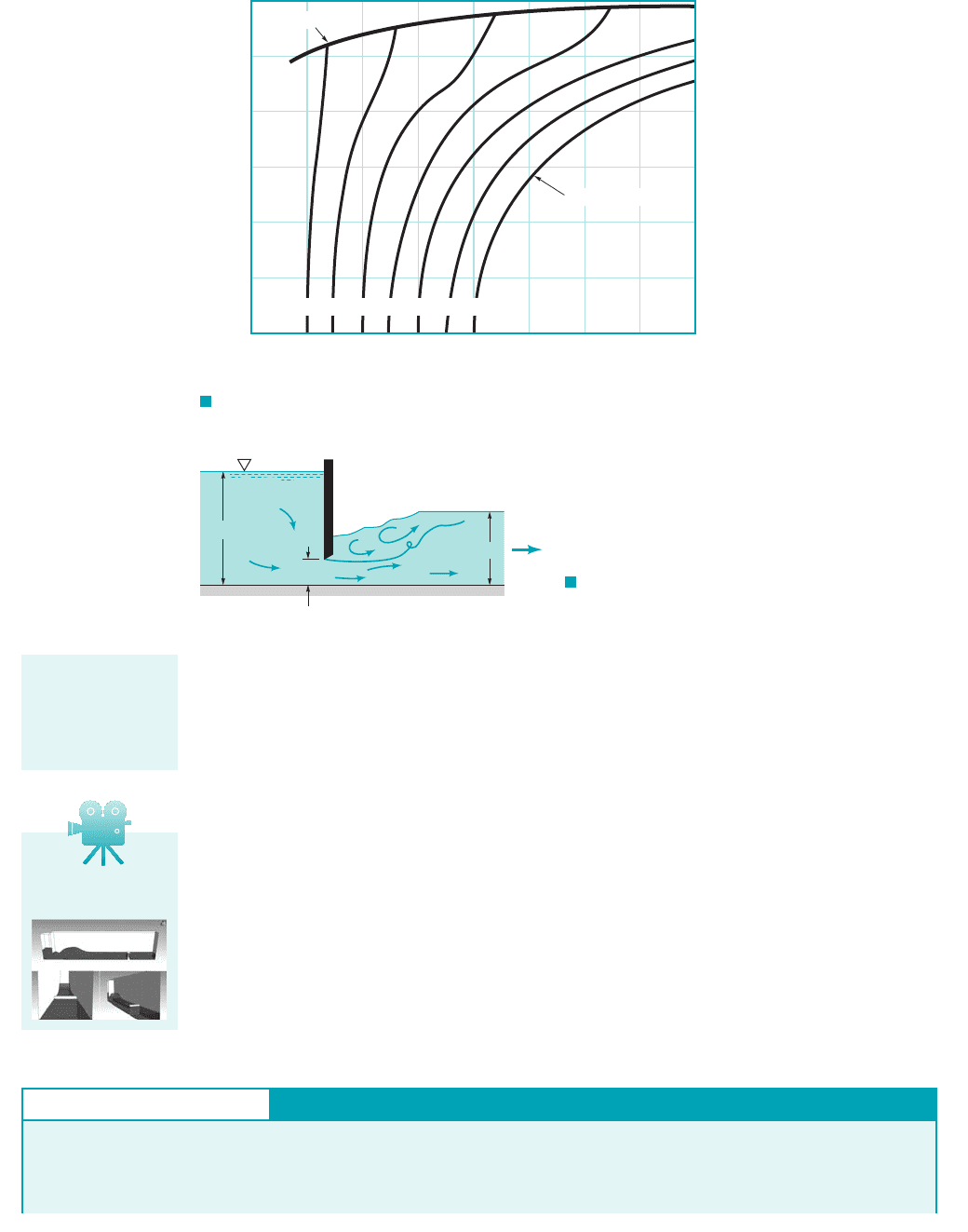
outflow 1or free discharge2from a vertical sluice gate are on the order of 0.55 to 0.60 as indicated
by the top line in Fig. 10.25 1Ref. 32.
As indicated in Fig. 10.26, in certain situations the depth downstream of the gate is controlled
by some downstream obstacle and the jet of water issuing from under the gate is overlaid by a
mass of water that is quite turbulent.
The flowrate for a submerged 1or drowned2gate can be obtained from the same equation
that is used for free outflow 1Eq. 10.352, provided the discharge coefficient is modified
appropriately. Typical values of for drowned outflow cases are indicated as the series of lower
curves in Fig. 10.25. Consider flow for a given gate and upstream conditions 1i.e., given 2
corresponding to a vertical line in the figure. With there is no head to
drive the flow so that and the fluid is stationary. For a given upstream depth 1 fixed2,
the value of increases with decreasing until the maximum value of is reached. This
maximum corresponds to the free discharge conditions and is represented by the free outflow line
so labeled in Fig. 10.25. For values of that give values between zero and its maximum,
the jet from the gate is overlaid 1drowned2by the downstream water and the flowrate is therefore
reduced when compared with a free discharge situation. Similar results are obtained for the radial
gate and drum gate.
C
d
y
3
Ⲑ
a
C
d
y
3
Ⲑ
aC
d
y
1
Ⲑ
aC
d
⫽ 0
y
3
Ⲑ
a ⫽ y
1
Ⲑ
a 1i.e., y
3
⫽ y
1
2
y
1
Ⲑ
a
C
d
10.6 Rapidly Varied Flow 567
F I G U R E 10.25 Typical discharge coefficients for underflow gates (Ref. 3).
Free outflow
Drowned outflow
0.6
0.5
0.4
0.3
0.2
0.1
0 2 4 6 8 10 12 14 16
y
1__
a
C
d
y
3__
a
=
2
3 4 5 6 7 8
F I G U R E 10.26 Drowned outflow
from a sluice gate.
q
a
y
3
y
1
The flowrate from
an underflow gate
depends on whether
the outlet is free or
drowned.
V10.16 Unsteady
under and over
GIVEN Water flows under the sluice gate shown in Fig. E10.9.
The channel width is the upstream depth is
and the gate is off the channel bottom.a ⫽ 1.0 ft
y
1
⫽ 6 ft,b ⫽ 20 ft,
Sluice Gate
E
XAMPLE 10.9
FIND Plot a graph of flowrate, Q, as a function of y
3
.
JWCL068_ch10_534-578.qxd 9/23/08 11:55 AM Page 567
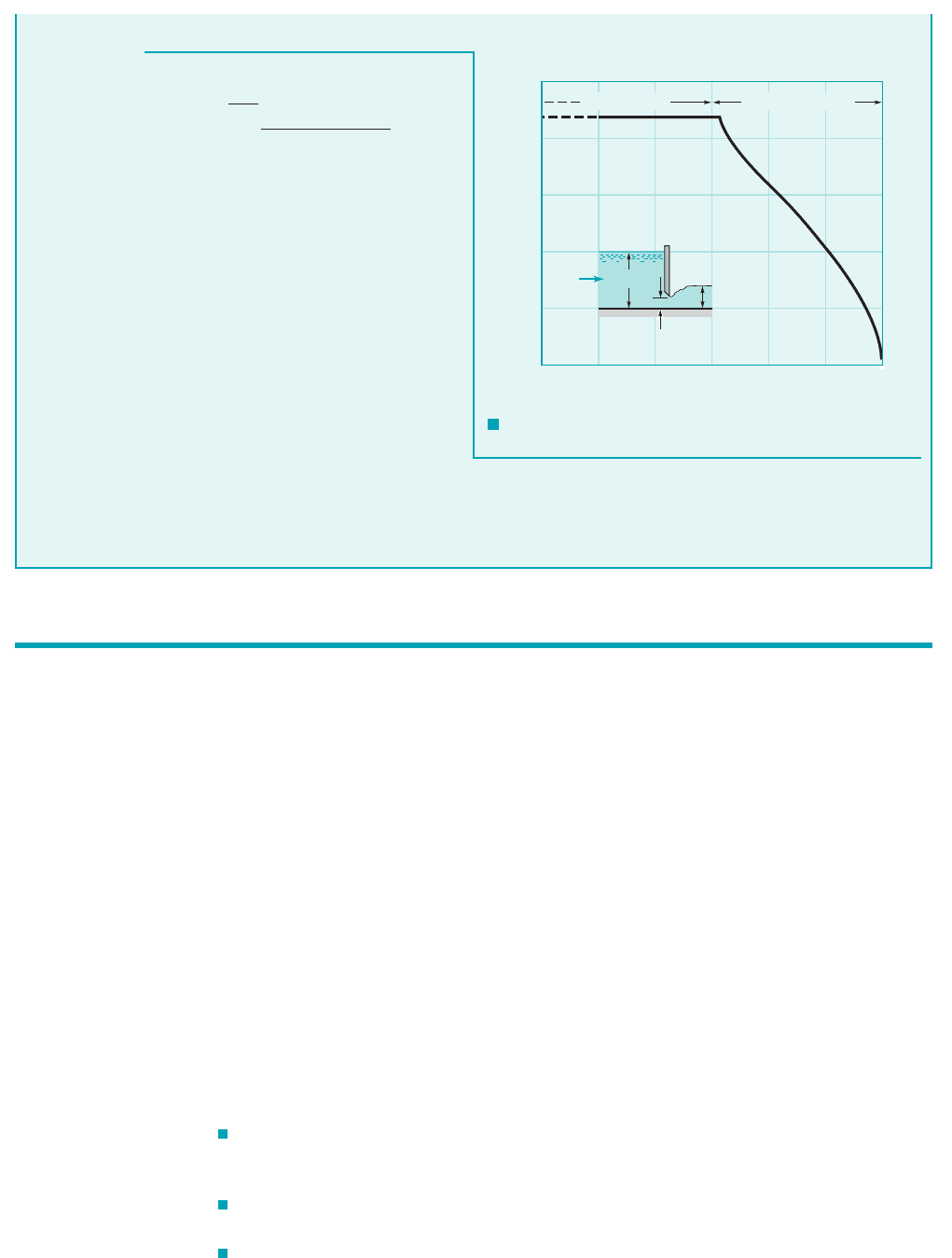
568 Chapter 10 ■ Open-Channel Flow
10.7 Chapter Summary and Study Guide
This chapter discussed various aspects of flows in an open channel. A typical open-channel flow
is driven by the component of gravity in the direction of flow. The character of such flows can
be a strong function of the Froude number, which is ratio of the fluid speed to the free-surface
wave speed. The specific energy diagram is used to provide insight into the flow processes
involved in open-channel flow.
Uniform depth channel flow is achieved by a balance between the potential energy lost by
the fluid as it coasts downhill and the energy dissipated by viscous effects. Alternately, it repre-
sents a balance between weight and friction forces. The relationship among the flowrate, the slope
of the channel, the geometry of the channel, and the roughness of the channel surfaces is given
by the Manning equation. Values of the Manning coefficient used in the Manning equation are
dependent on the surface material roughness.
The hydraulic jump is an example of nonuniform depth open-channel flow. If the Froude
number of a flow is greater than one, the flow is supercritical, and a hydraulic jump may occur.
The momentum and mass equations are used to obtain the relationship between the upstream
Froude number and the depth ratio across the jump. The energy dissipated in the jump and the
head loss can then be determined by use of the energy equation.
The use of weirs to measure the flowrate in an open channel is discussed. The relationships
between the flowrate and the weir head are given for both sharp-crested and broad-crested weirs.
The following checklist provides a study guide for this chapter. When your study of the
entire chapter and end-of-chapter exercises has been completed you should be able to
write out meanings of the terms listed here in the margin and understand each of the related
concepts. These terms are particularly important and are set in italic, bold, and color type
in the text.
determine the Froude number for a given flow and explain the concepts of subcritical, crit-
ical, and supercritical flows.
plot and interpret the specific energy diagram for a given flow.
S
OLUTION
From Eq. 10.35 we have
or
(1)
The value of is obtained from Fig. 10.25 along the vertical line
For we
obtain , indicating that there is no flow when there is no
head difference across the gate. The value of increases as
decreases, reaching a maximum of when
Thus, with
The flowrate for is obtained from Eq. 1 and
the values of Fig. 10.24 with the results as indicated in Fig.
E10.9.
COMMENT For the flowrate is independent of
and the outflow is a free 1not submerged2outflow. For such
cases the inertia of the water flowing under the gate is sufficient
to produce free outflow even with y
3
7 a.
y
3
,
y
3
6 3.2 ft
C
d
3.2 ft y
3
6 ft
Q 393 10.562 cfs 220 cfs
y
3
3.2a 3.2 ft
y
3
a 3.2.C
d
0.56
y
3
aC
d
C
d
0
y
3
6 ft 1i.e., y
3
a 6 y
1
a2y
1
a 6 ft
1 ft 6.
C
d
Q 393C
d
cfs
20 ft 11.0 ft2 C
d
22132.2 ft
s
2
216.0 ft2
Q bq baC
d
12gy
1
F I G U R E E10.9
Q
y
3
a = 1 ft
012345
6
0
50
100
150
200
250
y
3
, ft
Q, cfs
Free outflow Submerged outflow
y
1
= 6 ft
open-channel flow
Froude number
critical flow
subcritical flow
supercritical flow
wave speed
specific energy
specific energy diagram
uniform depth flow
wetted perimeter
hydraulic radius
Chezy equation
Manning equation
Manning coefficient
rapidly varied flow
hydraulic jump
sharp-crested weir
weir head
broad-crested weir
underflow gate
JWCL068_ch10_534-578.qxd 9/23/08 11:55 AM Page 568

use the Manning equation to analyze uniform depth flow in an open channel.
calculate properties such as the depth ratio and the head loss for a hydraulic jump.
determine the flowrates over sharp-crested weirs, broad-crested weirs, and under underflow gates.
Some of the important equations in this chapter are:
Froude number
Wave speed (10.3)
Specific energy (10.8)
Manning equation (10.19)
Hydraulic jump depth ratio (10.24)
Hydraulic jump head loss
(10.25)
Rectangular sharp-crested weir (10.30)
Triangular sharp-crested weir (10.32)
Broad-crested weir (10.33)
Underflow gate (10.35)q C
d
a12gy
1
Q C
wb
b 1g a
2
3
b
3
2
H
3
2
Q C
wt
8
15
tan a
u
2
b 12g H
5
2
Q C
wr
2
3
12g b H
3
2
h
L
y
1
1
y
2
y
1
Fr
1
2
2
c1 a
y
1
y
2
b
2
d
y
2
y
1
1
2
11 21 8Fr
1
2
2
V
k
n
R
h
2
3
S
0
1
2
E y
V
2
2g
c 1gy
Fr V
1gy2
1
2
Review Problems 569
1. Currie, C. G., and Currie, I. G., Fundamental Mechanics of Fluids, Third Edition, Marcel Dekker,
New York, 2003.
2. Stoker, J. J., Water Waves, Interscience, New York, 1957.
3. Henderson, F. M., Open Channel Flow, Macmillan, New York, 1966.
4. Rouse, H., Elementary Fluid Mechanics, Wiley, New York, 1946.
5. French, R. H., Open Channel Hydraulics, McGraw-Hill, New York, 1992.
6. Chow, V. T., Open Channel Hydraulics, McGraw-Hill, New York, 1959.
7. Blevins, R. D., Applied Fluid Dynamics Handbook, Van Nostrand Reinhold, New York, 1984.
8. Daugherty, R. L., and Franzini, J. B., Fluid Mechanics with Engineering Applications, McGraw-Hill,
New York, 1977.
9. Vennard, J. K., and Street, R. L., Elementary Fluid Mechanics, Seventh Edition Wiley, New York, 1995.
10. Lenz, A. T., “Viscosity and Surface Tension Effects on V-Notch Weir Coefficients,” Transactions of
the American Society of Chemical Engineers, Vol. 108, 759–820, 1943.
11. White, F. M., Fluid Mechanics, 5th Ed., McGraw-Hill, New York, 2003.
12. U.S. Bureau of Reclamation, Research Studies on Stilling Basins, Energy Dissipators, and Associated
Appurtenances, Hydraulic Lab Report Hyd.-399, June 1, 1955.
13. Wallet, A., and Ruellan, F., Houille Blanche, Vol. 5, 1950.
14. Spitzer, D. W., ed., Flow Measurement: Practical Guides for Measurement and Control, Instrument
Society of America, Research Triangle Park, NC, 1991.
References
Review Problems
Go to Appendix G for a set of review problems with answers. De-
tailed solutions can be found in Student Solution Manual and Study
Guide for Fundamentals of Fluid Mechanics, by Munson et al.
(© 2009 John Wiley and Sons, Inc.).
JWCL068_ch10_534-578.qxd 9/23/08 11:55 AM Page 569
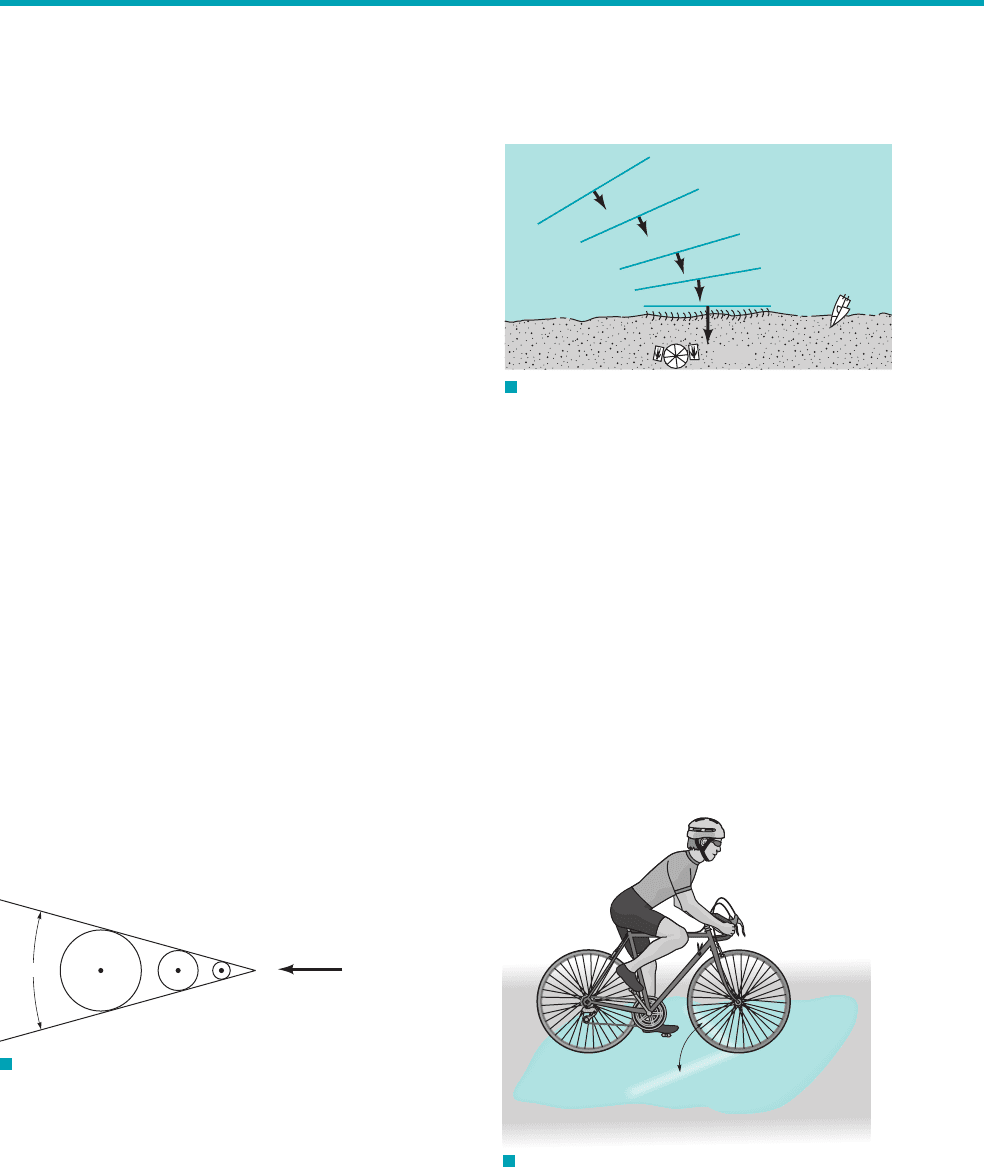
570 Chapter 10 ■ Open-Channel Flow
10.9 Observations at a shallow sandy beach show that even though
the waves several hundred yards out from the shore are not parallel
to the beach, the waves often “break” on the beach nearly parallel to
the shore as indicated in Fig. P10.9. Explain this behavior based
on the wave speed c ⫽ 1gy2
1
Ⲑ
2
.
Problems
Note: Unless otherwise indicated, use the values of fluid
properties found in the tables on the inside of the front cover.
Problems designated with an (
*) are intended to be solved
with the aid of a programmable calculator or a computer.
Problems designated with a (
†) are “open-ended” problems
and require critical thinking in that to work them one must
make various assumptions and provide the necessary data.
There is not a unique answer to these problems.
Answers to the even-numbered problems are listed at the
end of the book. Access to the videos that accompany problems
can be obtained through the book’s web site, www.wiley.com/
college/munson. The lab-type problems can also be accessed on
this web site.
Section 10.2 Surface Waves
10.1 Obtain a photograph image of surface waves. Print this photo
and write a brief paragraph that describes the similarities and
differences between these waves and those depicted in Fig. 10.4.
10.2 On a distant planet small amplitude waves travel across a
1-m-deep pond with a speed of 5 m s. Determine the acceleration
of gravity on the surface of that planet.
10.3 The flowrate in a 50-ft-wide, 2-ft-deep river is Q ⫽ 190 cfs.
Is the flow subcritical or supercritical?
10.4 The flowrate per unit width in a wide channel is
Is the flow subcritical or supercritical if the depth is (a) 0.2 m, (b)
0.8 m, or (c) 2.5 m?
10.5 A rectangular channel 3 m wide carries at a depth
of 2 m. Is the flow subcritical or supercritical? For the same
flowrate, what depth will give critical flow?
10.6 Consider waves made by dropping objects (one after another
from a fixed location) into a stream of depth y that is moving with
speed V as shown in Fig. P10.6 (see Video V10.5). The circular
wave crests that are produced travel with speed relative
to the moving water. Thus, as the circular waves are washed
downstream, their diameters increase and the center of each circle
is fixed relative to the moving water. (a) Show that if the flow is
supercritical, lines tangent to the waves generate a wedge of half-
angle where is the Froude
number. (b) Discuss what happens to the wave pattern when the
flow is subcritical,
Fr 6 1.
Fr ⫽ V
Ⲑ
1gy2
1
Ⲑ
2
a
Ⲑ
2 ⫽ arcsin11
Ⲑ
Fr2,
c ⫽ 1gy2
1
Ⲑ
2
10 m
3
Ⲑ
s
2.3 m
2
Ⲑ
s.q ⫽
Ⲑ
Ⲑ
F I G U R E P10.6
V
α
10.7 Waves on the surface of a tank are observed to travel at a speed
of 2 m兾s. How fast would these waves travel if (a) the tank were in
an elevator accelerating downward at a rate of (b) the tank
accelerates horizontally at a rate of (c) the tank were
aboard the orbiting Space Shuttle? Explain.
10.8 In flowing from section 112to section 122along an open
channel, the water depth decreases by a factor of two and the
Froude number changes from a subcritical value of 0.5 to a
supercritical value of 3.0. Determine the channel width at 122if it
is 12 ft wide at 112.
9.81 m
Ⲑ
s
2
,
4 m
Ⲑ
s
2
,
F I G U R E P10.9
Wave crest
Ocean
c
Beach
†10.10 Explain, physically, why surface tension increases the
speed of surface waves.
10.11 Often when an earthquake shifts a segment of the ocean
floor, a relatively small amplitude wave of very long wavelength
is produced. Such waves go unnoticed as they move across the open
ocean; only when they approach the shore do they become
dangerous 1a tsunami or “tidal wave”2. Determine the wave speed
if the wavelength, is 6000 ft and the ocean depth is 15,000 ft.
10.12 A bicyclist rides through a 3-in.-deep puddle of water as
shown in Video V10.5 and Fig. P10.12. If the angle made by the
V-shaped wave pattern produced by the front wheel is observed
to be 40°, estimate the speed of the bike through the puddle.
Hint: Make a sketch of the current location of the bike wheel
relative to where it was seconds ago. Also indicate on this
sketch the current location of the wave that the wheel made
seconds ago. Recall that the wave moves radially outward in all
directions with speed c relative to the stationary water.
¢t
¢t
l,
F I G U R E P10.12
40°
10.13 Determine the minimum depth in a 3-m-wide rectangular
channel if the flow is to be subcritical with a flowrate of
10.14 (See Fluids in the News article titled “Tsunami, the nonstorm
wave,” Section 10.2.1.) An earthquake causes a shift in the ocean
floor that produces a tsunami with a wavelength of 100 km. How
Q ⫽ 60 m
3
Ⲑ
s.
JWCL068_ch10_534-578.qxd 9/30/08 8:33 AM Page 570
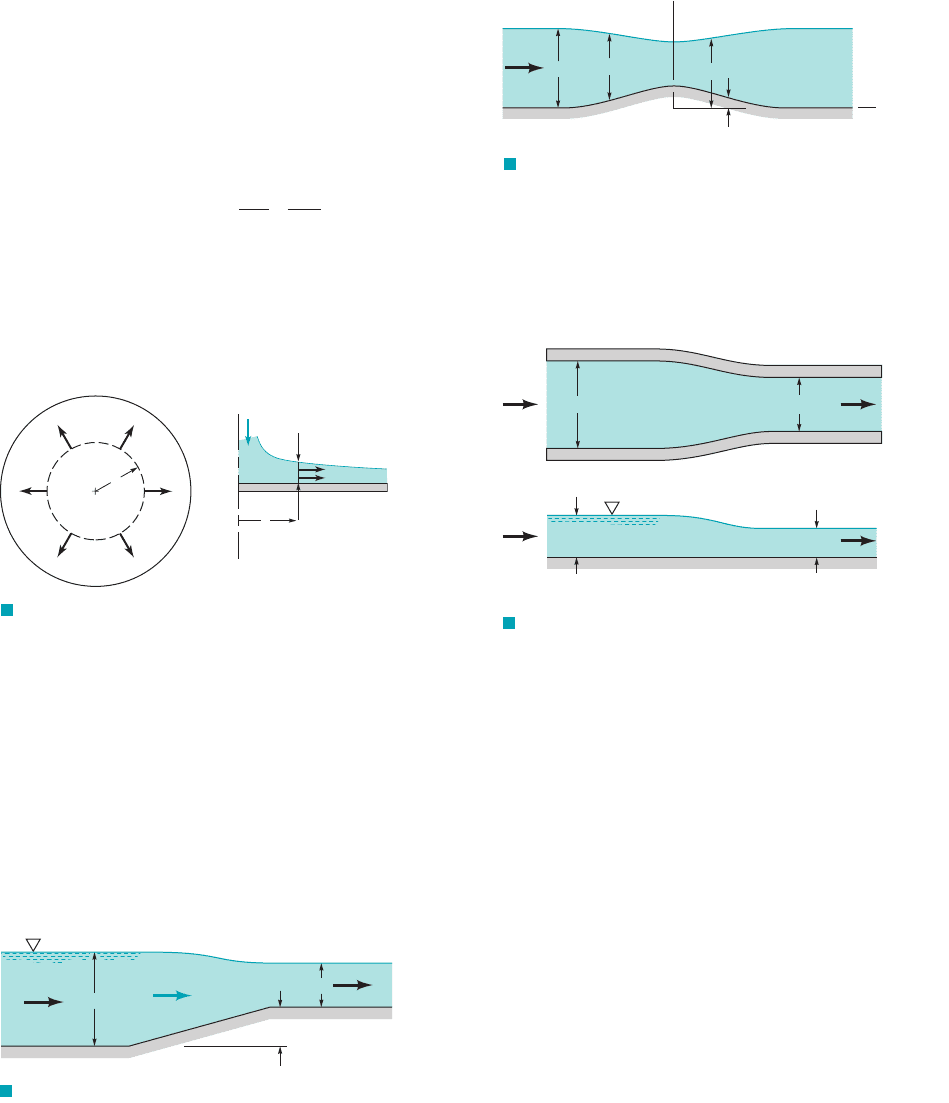
fast will this wave travel across the ocean surface if the ocean depth
is 3000 m?
Section 10.3 Energy Considerations
10.15 Water flows in a 10-m-wide open channel with a flowrate
of 5 m
3
s. Determine the two possible depths if the specific energy
of the flow is E 0.6 m.
10.16 Water flows in a rectangular channel with a flowrate per
unit width of Plot the specific energy diagram for
this flow. Determine the two possible depths of flow if
10.17 Water flows radially outward on a horizontal round disk as
shown in Video V10.12 and Fig. P10.17. (a) Show that the specific
energy can be written in terms of the flowrate, Q, the radial distance
from the axis of symmetry, r, and the fluid depth, y, as
(b) For a constant flowrate, sketch the specific energy diagram.
Recall Fig. 10.7, but note that for the present case r is a variable.
Explain the important characteristics of your sketch. (c) Based on the
results of Part (b), show that the water depth increases in the flow
direction if the flow is subcritical, but that it decreases in the flow
direction if the flow is supercritical.
E y a
Q
2pr
b
2
1
2gy
2
E 2.5 m.
q 2.5 m
2
s.
Problems 571
F I G U R E P10.17
r
y
V
V
r
10.18 Water flows in a 10-ft-wide rectangular channel with a flowrate
of 200 ft
3
/s. Plot the specific energy diagram for this flow. Determine
the two possible flowrates when the specific energy is 6 ft.
10.19 Water flows in a rectangular channel at a rate of
When a Pitot tube is placed in the stream, water in
the tube rises to a level of 4.5 ft above the channel bottom.
Determine the two possible flow depths in the channel. Illustrate
this flow on a specific energy diagram.
10.20 Water flows in a 5-ft-wide rectangular channel with a
flowrate of and an upstream depth of as
is shown in Fig. P10.20. Determine the flow depth and the surface
elevation at section 122.
y
1
2.5 ftQ 30 ft
3
s
q 20 cfs
ft.
F I G U R E P10.20
V
1
Q
V
2
y
1
y
2
0.2 ft
(2)
(1)
10.21 Repeat Problem 10.20 if the upstream depth is
*10.22 Water flows over the bump in the bottom of the rectangular
channel shown in Fig. P10.22 with a flowrate per unit width of
y
1
0.5 ft.
The channel bottom contour is given by
where and x are in meters. The water depth far upstream of the
bump is Plot a graph of the water depth, and
the surface elevation, for Assume one-
dimensional flow.
x 4 m.4 mz z1x2,
y y1x2,y
1
2 m.
z
B
z
B
0.2e
x
2
,q 4 m
2
s.
F I G U R E P10.22
0
V
1
y
1
z
x
y(x)
z(x)
z
B
= 0.2e
–x
2
*10.23 Repeat Problem 10.22 if the upstream depth is 0.4 m.
10.24 Water in a rectangular channel flows into a gradual
contraction section as is indicated in Fig. P10.24. If the flowrate
is and the upstream depth is determine the
downstream depth, y
2
.
y
1
2 ft,Q 25 ft
3
s
F I G U R E P10.24
V
1
V
2
V
1
V
2
(2)(1)
y
1
y
2
Side view
Top view
b
2
= 3 ft
b
1
= 4 ft
10.25 Sketch the specific energy diagram for the flow of Problem
10.24 and indicate its important characteristics. Note that
10.26 Repeat Problem 10.24 if the upstream depth is
Assume that there are no losses between sections 112and 122.
10.27 Water flows in a rectangular channel with a flowrate per
unit width of and a depth of 0.5 m at section 112. The
head loss between sections 112and 122is 0.03 m. Plot the specific
energy diagram for this flow and locate states 112and 122on this
diagram. Is it possible to have a head loss of 0.06 m? Explain.
10.28 Water flows in a horizontal rectangular channel with a
flowrate per unit width of and a depth of 1.0 ft at the
downstream section 122. The head loss between section 112upstream
and section 122is 0.2 ft. Plot the specific energy diagram for this
flow and locate states 112and 122on this diagram.
10.29 Water flows in a horizontal, rectangular channel with an
initial depth of 1 m and an initial velocity of 4 m兾s. Determine the
depth downstream if losses are negligible. Note that there may be
more than one solution.
10.30 A smooth transition section connects two rectangular
channels as shown in Fig. P10.30. The channel width increases
from 6.0 to 7.0 ft and the water surface elevation is the same in
each channel. If the upstream depth of flow is 3.0 ft, determine h,
the amount the channel bed needs to be raised across the transition
section to maintain the same surface elevation.
q 10 ft
2
s
q 1.5 m
2
s
y
1
0.5 ft.
q
1
q
2
.
JWCL068_ch10_534-578.qxd 9/23/08 11:56 AM Page 571
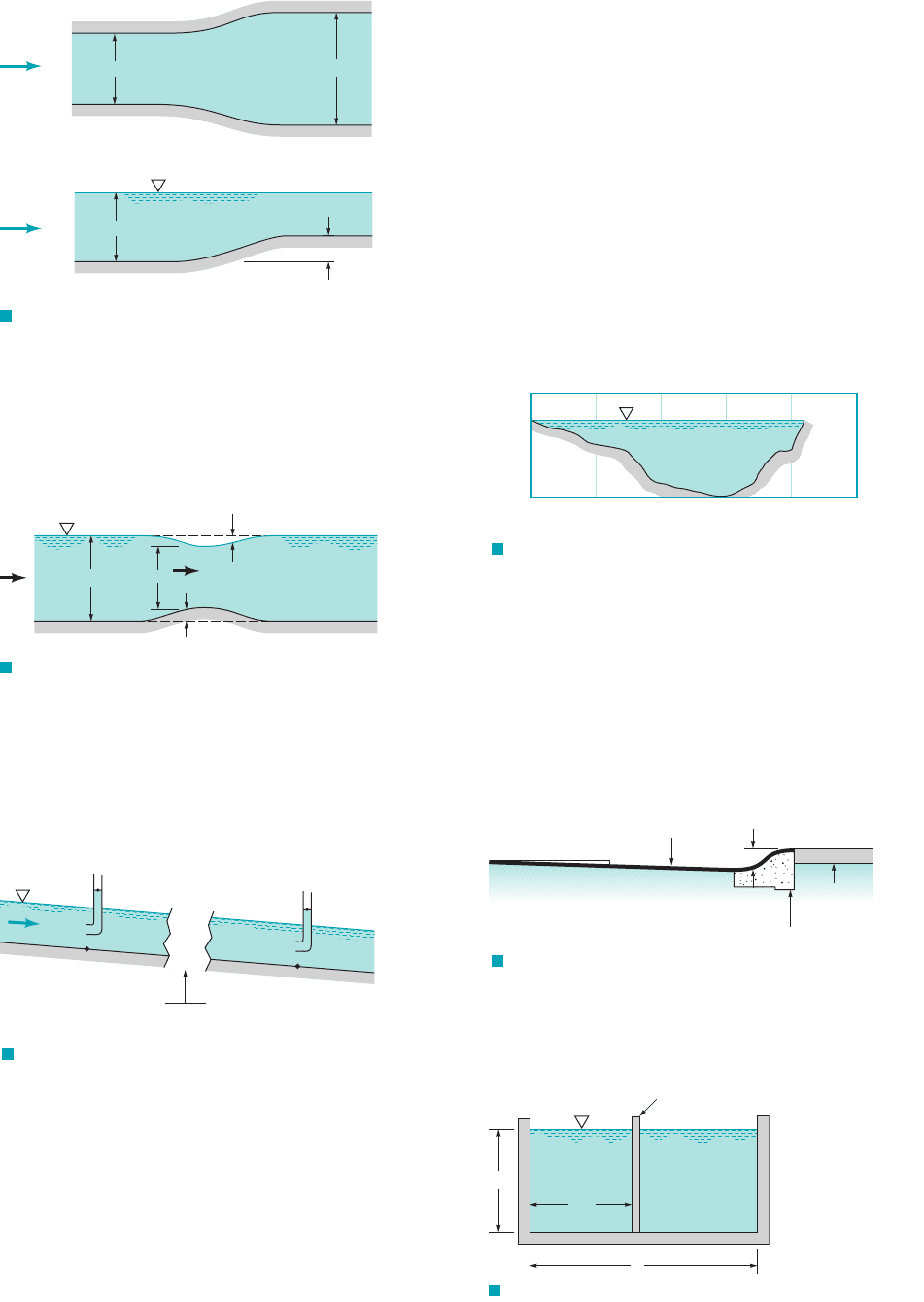
10.31 Water flows over a bump of height on the bottom
of a wide rectangular channel as is indicated in Fig. P10.31. If energy
losses are negligible, show that the slope of the water surface is
given by where and
are the local velocity and depth of flow. Comment on the
sign of relative to the sign of dh
Ⲑ
dx.dy
Ⲑ
dx1i.e., 60, ⫽ 0, or 702
y ⫽ y1x2
V ⫽ V1x2gy24,dy
Ⲑ
dx ⫽⫺1dh
Ⲑ
dx2
Ⲑ
31 ⫺ 1V
2
Ⲑ
h ⫽ h1x2
10.37 Fluid properties such as viscosity or density do not appear
in the Manning equation (Eq. 10.20). Does this mean that this
equation is valid for any open-channel flow such as that involving
mercury, water, oil, or molasses? Explain.
10.38 The following data are taken from measurements on Indian
Fork Creek: A⫽ 26 m
2
,P ⫽ 16 m, and S
0
⫽ 0.02 m 62 m. Determine
the average shear stress on the wetted perimeter of this channel.
10.39 The following data are obtained for a particular reach of the
Provo River in Utah: free-surface width
average depth length of
and elevation drop of Determine
(a) the average shear stress on the wetted perimeter, (b) the
Manning coefficient, n, and (c) the Froude number of the flow.
10.40 At a particular location the cross section of the Columbia
River is as indicated in Fig. P10.40. If on a day without wind it takes
5 min to float 0.5 mi along the river, which drops 0.46 ft in that
distance, determine the value of the Manning coefficient, n.
reach ⫽ 1.04 ft.reach ⫽ 116 ft,
V ⫽ 6.56 ft
Ⲑ
s,R
h
⫽ 3.22 ft,⫽ 3.3 ft,
⫽ 55 ft,A ⫽ 183 ft
2
,
Ⲑ
10.32 Integrate the differential equation obtained in Problem
10.31 to determine the draw-down distance, indicated in
Fig. P10.31. Comment on your results.
10.33 Water flows in the river shown in Fig. P10.33 with a uniform
bottom slope. The total head at each section is measured by using
Pitot tubes as indicated. Determine the value of at the
location where the Froude number is 0.357.
dy
Ⲑ
dx
/ ⫽ /1x2,
10.34 Repeat Problem 10.33 if the Froude number is 2.75.
10.35 Water flows in a horizontal rectangular channel at a depth
of 0.5 ft and a velocity of 8 ft兾s. Determine the two possible depths
at a location slightly downstream. Viscous effects between the
water and the channel surface are negligible.
Section 10.4.2 The Manning Equation
10.36 Water flows in a 5-m-wide channel with a speed of 2 m/s
and a depth of 1 m. The channel bottom slopes at a rate of 1 m
per 1000 m. Determine the Manning coefficient for this channel.
572 Chapter 10 ■ Open-Channel Flow
F I G U R E P10.30
6 ft 7 ft
Q
Q
Top view
Side view
3 ft
h
F I G U R E P10.31
V
1
V(x)
y
1
y
h
(x)
ᐉ(x)
x
F I G U R E P10.33
(2)
(1)
(4)
(3)
Q
z
z
1
= 620.1 ft
z
3
= 628.3 ft
x
2
– x
1
= 4100 ft
z
2
= 618.7 ft
z
4
= 625.0 ft
F I G U R E P10.40
60
40
20
0
0 400 800 1200 1600 2000
Width, ft
Depth, ft
F I G U R E P10.42
Asphalt street
6 in.
1
10
Sidewalk
Concrete curb
F I G U R E P10.43
b/2
b/2
b
Center board
Section 10.4.3 Uniform Depth Examples—Determine
Flowrate
10.41 A 2-m-diameter pipe made of finished concrete lies on a slope
of 1 m elevation change per 1000 m horizontal distance. Determine
the flowrate when the pipe is half full.
10.42 Rainwater flows down a street whose cross section is shown
in Fig. P10.42. The street is on a hill at an angle of 2°. Determine
the maximum flowrate possible if the water is not to overflow onto
the sidewalk.
10.43 By what percent is the flowrate reduced in the rectangular
channel shown in Fig. P10.43 because of the addition of the thin
center board? All surfaces are of the same material.
JWCL068_ch10_534-578.qxd 9/30/08 8:34 AM Page 572
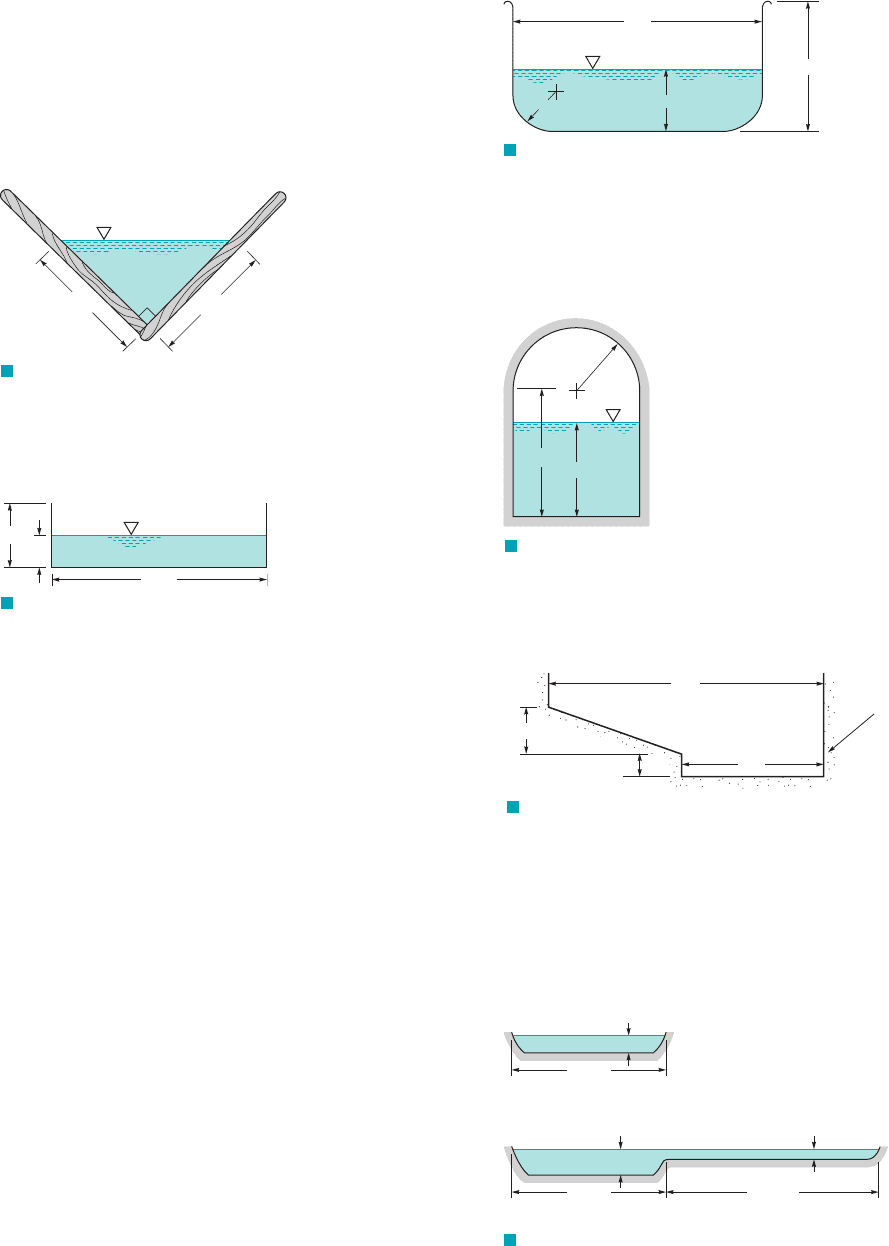
10.44 The great Kings River flume in Fresno County, California,
was used from 1890 to 1923 to carry logs from an elevation of
4500 ft where trees were cut to an elevation of 300 ft at the railhead.
The flume was 54 miles long, constructed of wood, and had a V-
cross section as indicated in Fig. P10.44. It is claimed that logs
would travel the length of the flume in 15 hours. Do you agree
with this claim? Provide appropriate calculations to support your
answer.
*10.53 The cross section of a long tunnel carrying water through
a mountain is as indicated in Fig. P10.53. Plot a graph of flowrate
as a function of water depth, y, for . The slope is
2 ft兾mi and the surface of the tunnel is rough rock (equivalent to
rubble masonry). At what depth is the flowrate maximum? Explain.
0 y 18 ft
10.54 The smooth concrete-lined channel shown in Fig. P10.54 is
built on a slope of 2 m兾km. Determine the flowrate if the depth is
y 1.5 m.
*10.55 At a given location, under normal conditions a river flows
with a Manning coefficient of 0.030 and a cross section as indicated
in Fig. P10.55a. During flood conditions at this location, the river
has a Manning coefficient of 0.040 (because of trees and brush in
the floodplain) and a cross section as shown in Fig. P10.55b.
Determine the ratio of the flowrate during flood conditions to that
during normal conditions.
Problems
573
F I G U R E P10.44
1 ft
1 ft
F I G U R E P10.45
2 d
d
10 d
10.45 Water flows in a channel as shown in Fig. P10.45. The velocity
is 4.0 ft兾s when the channel is half full with depth d. Determine the
velocity when the channel is completely full, depth 2d.
10.46 A trapezoidal channel with a bottom width of 3.0 m and
sides with a slope of 2 : 1 1horizontal:vertical2is lined with fine
gravel and is to carry Can this channel be10 m
3
s.1n 0.0202
built with a slope of if it is necessary to keep the
velocity below 0.75 m兾s to prevent scouring of the bottom?
Explain.
10.47 Water flows in a 2-m-diameter finished concrete pipe so
that it is completely full and the pressure is constant all along the
pipe. If the slope is determine the flowrate by using
open-channel flow methods. Compare this result with that obtained
by using pipe flow methods of Chapter 8.
10.48 Water flows in a weedy earthen channel at a rate of 30 m
3
兾s.
What flowrate can be expected if the weeds are removed and the
depth remains constant?
10.49 A round concrete storm sewer pipe used to carry rainfall
runoff from a parking lot is designed to be half full when the
rainfall rate is a steady 1 in.兾hr. Will this pipe be able to handle
the flow from a 2-in.兾hr rainfall without water backing up into the
parking lot? Support your answer with appropriate calculations.
10.50 A 10-ft-wide rectangular channel is built to bypass a dam
so that fish can swim upstream during their migration. During
normal conditions when the water depth is 4 ft, the water velocity
is Determine the velocity during a flood when the water
depth is 8 ft.
†10.51 Overnight a thin layer of ice forms on the surface of a
river. Estimate the percent reduction in flowrate caused by this
condition. List all assumptions and show all calculations.
*10.52 Water flows in the painted steel rectangular channel with
rounded corners shown in Fig. P10.52. The bottom slope is
1 ft兾200 ft. Plot a graph of flowrate as a function of water depth
for with corner radii of 0.2, 0.4, 0.6, 0.8, and
1.0 ft.
r 0,0 y 1 ft
5 ft
s.
S
0
0.005,
S
0
0.00010
F I G U R E P10.52
y
2 ft
1 ft
r
F I G U R E P10.53
12 ft
y
6 ft
F I G U R E P10.54
0.5 m
1.0 m
6 m
3 m
Concrete
F I G U R E P10.55
800 ft
12 ft
(
a)
800 ft
20 ft
(
b)
1000 ft
8 ft
10.56 Repeat Problem 10.54 if the surfaces are smooth concrete
as is indicated, except for the diagonal surface, which is gravelly
with n 0.025.
JWCL068_ch10_534-578.qxd 9/23/08 11:56 AM Page 573
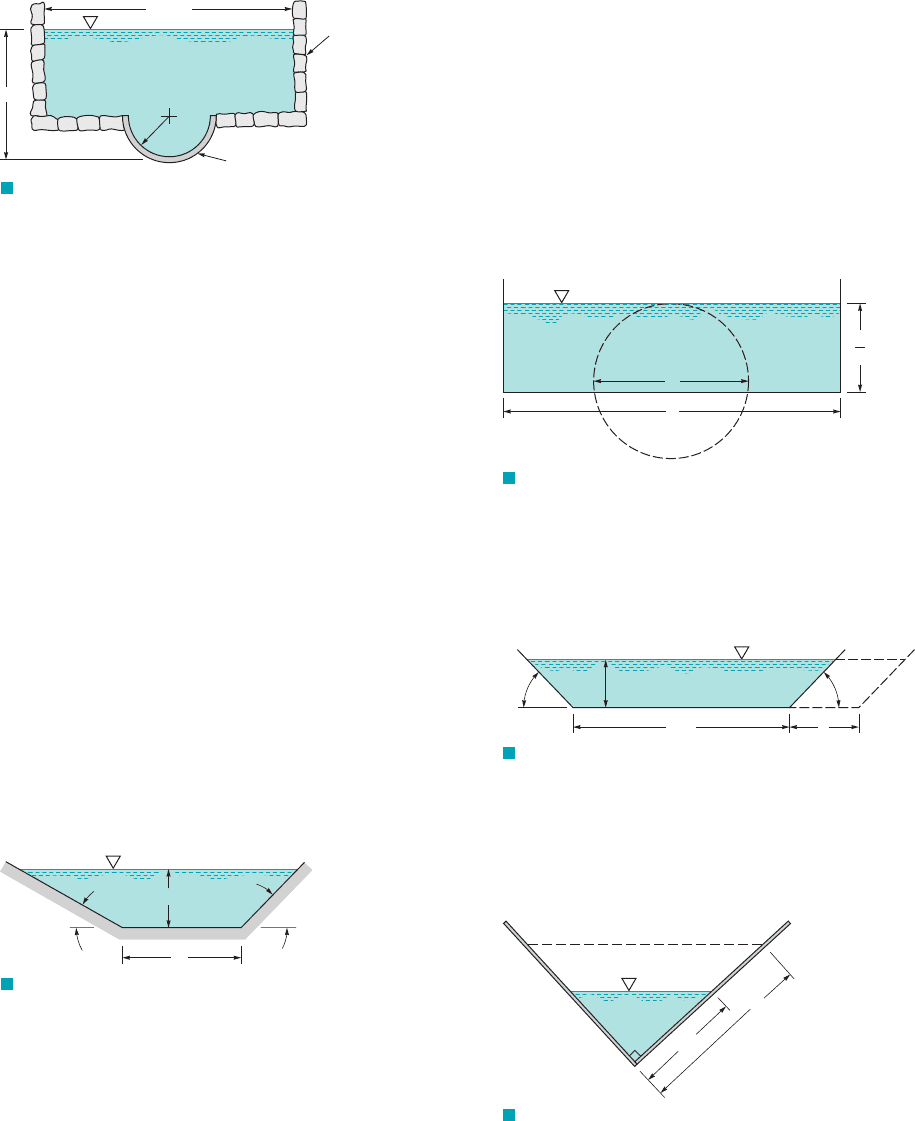
*10.57 Water flows through the storm sewer shown in Fig. P10.57.
The slope of the bottom is Plot a graph of the flowrate
as a function of depth for On the same graph, plot
the flowrate expected if the entire surface were lined with material
similar to that of a clay tile.
0 y 1.7 m.
2 m
400 m.
574 Chapter 10 ■ Open-Channel Flow
10.66 An engineer is to design a channel lined with planed wood
to carry water at a flowrate of on a slope of
The channel cross section can be either a triangle or a rectangle
with a cross section twice as wide as its depth. Which would require
less wood and by what percent?
10.67 A circular finished concrete culvert is to carry a discharge
of on a slope of 0.0010. It is to flow not more than half-
full. The culvert pipes are available from the manufacture with
diameters that are multiples of 1 ft. Determine the smallest suitable
culvert diameter.
10.68 At what depth will of water flow in a 6-ft-wide
rectangular channel lined with rubble masonry set on a slope of
1 ft in 500 ft? Is a hydraulic jump possible under these conditions?
Explain.
10.69 The rectangular canal shown in Fig. P10.69 changes to a
round pipe of diameter D as it passes through a tunnel in a mountain.
Determine D if the surface material and slope remain the same and
the round pipe is to flow completely full.
50 ft
3
s
50 ft
3
s
90°
10 m
800 m.2 m
3
s
10.58 Determine the flowrate for the symmetrical channel shown
in Fig. P10.80 if the bottom is smooth concrete and the sides are
weedy. The bottom slope is
10.59 (See Fluids in the News article titled “Done without a GPS
or lasers,” Section 10.4.3.) Determine the number of gallons of wa-
ter delivered per day by a rubble masonry, 1.2-m-wide aqueduct
laid on an average slope of 14.6 m per 50 km if the water depth is
1.8 m.
Section 10.4.3 Uniform Depth Examples—Determine
Depth or Size
10.60 Water flows in a rectangular, finished concrete channel at
a rate of . The bottom slope is 0.001. Determine the channel
width if the water depth is to be equal to its width.
10.61 An old, rough-surfaced, 2-m-diameter concrete pipe with a
Manning coefficient of 0.025 carries water at a rate of 5.0 m
3
/s
when it is half full. It is to be replaced by a new pipe with a Manning
coefficient of 0.012 that is also to flow half full at the same flowrate.
Determine the diameter of the new pipe.
10.62 Four sewer pipes of 0.5-m diameter join to form one pipe
of diameter D. If the Manning coefficient, n, and the slope are
the same for all of the pipes, and if each pipe flows half-full,
determine D.
10.63 The flowrate in the clay-lined channel shown
in Fig. P10.63 is to be To prevent erosion of the sides,
the velocity must not exceed 5 ft s. For this maximum velocity,
determine the width of the bottom, b, and the slope, S
0
.
300 ft
3
s.
1n 0.0252
2 m
3
s
S
0
0.001.
10.64 Overnight a thin layer of ice forms on the surface of a 40-
ft-wide river that is essentially of rectangular cross-sectional shape.
Under these conditions the flow depth is 3 ft. During the following
day the sun melts the ice cover. Determine the new depth if the
flowrate remains the same and the surface roughness of the ice is
essentially the same as that for the bottom and sides of the river.
10.65 A rectangular, unfinished concrete channel of 28-ft-width
is laid on a slope of 8 ft兾mi. Determine the flow depth and Froude
number of the flow if the flowrate is 400 ft
3
s.
F I G U R E P10.57
0.5 m
Clay tile
Rubble
masonry
2.5 m
y
F I G U R E P10.63
b
2 ft
45°
30°
F I G U R E P10.70
3 m
8 m
L
45
45
F I G U R E P10.69
D
b
b
2
10.70 The flowrate through the trapezoidal canal shown in Fig.
P10.70 is Q. If it is desired to double the flowrate to 2Q without
changing the depth, determine the additional width, L, needed. The
bottom slope, surface material, and the slope of the walls are to
remain the same.
F I G U R E P10.71
2 m
L
10.71 When the channel of triangular cross section shown in Fig.
P10.71 was new, a flowrate of Q caused the water to reach
up the side as indicated. After considerable use, the walls of the
channel became rougher and the Manning coefficient, n, doubled.
Determine the new value of L if the flowrate stayed the same.
L 2 m
10.72 A smooth steel water slide at an amusement park is of
semicircular cross section with a diameter of 2.5 ft. The slide
descends a vertical distance of 35 ft in its 420-ft length. If pumps
JWCL068_ch10_534-578.qxd 9/23/08 11:56 AM Page 574
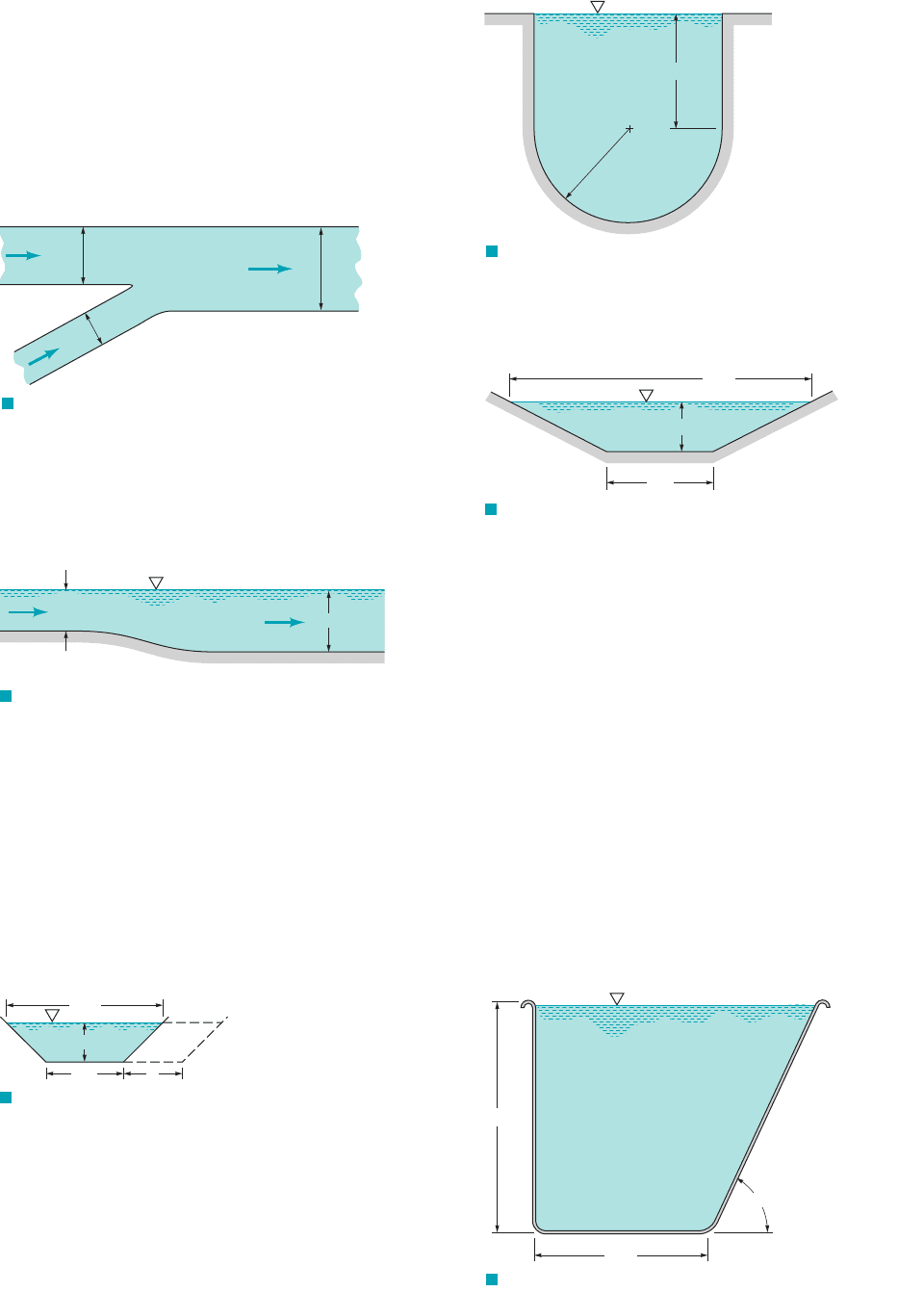
supply water to the slide at a rate of 6 cfs, determine the depth of
flow. Neglect the effects of the curves and bends of the slide.
10.73 Two canals join to form a larger canal as shown in Video
V10.6 and Fig. P10.73. Each of the three rectangular canals is
lined with the same material and has the same bottom slope. The
water depth in each is to be 2 m. Determine the width of the
merged canal, b. Explain physically (i.e., without using any
equations) why it is expected that the width of the merged canal
is less than the combined widths of the two original canals (i.e.,
b 6 4 m 8 m 12 m2.
Problems
575
10.74 Water flows uniformly at a depth of 1 m in a channel that is
5 m wide as shown in Fig. P10.74. Further downstream the channel
cross section changes to that of a square of width and height b.
Determine the value of b if the two portions of this channel are made
of the same material and are constructed with the same bottom slope.
F I G U R E P10.73
8 m
4 m
b
Q
2
Q
1
Q
3
F I G U R E P10.74
1 m
b
Width = 5 m
10.75 Determine the flow depth for the channel shown in Fig.
P10.54 if the flowrate is
10.76 Rainwater runoff from a 200-ft by 500-ft parking lot is to
drain through a circular concrete pipe that is laid on a slope of
3 ft兾mi. Determine the pipe diameter if it is to be full with a steady
rainfall of 1.5 in.兾hr.
10.77 (See Fluids in the News article titled “Plumbing the Ever-
glades,” Section 10.4.1.) The canal shown in Fig. P10.77 is to be
widened so that it can carry twice the amount of water. Determine the
additional width, L, required if all other parameters (i.e., flow depth,
bottom slope, surface material, side slope) are to remain the same.
15 m
3
s.
F I G U R E P10.77
5 ft
2 ft
10 ft
L
Section10.4.3 Uniform Depth Examples—Determine Slope
10.78 Water flows 1 m deep in a 2-m-wide finished concrete
channel. Determine the slope if the flowrate is
10.79 Water flows in the channel shown in Fig. P10.79 at a rate
of Determine the minimum slope that this channel can
have so that the water does not overflow the sides. The Manning
coefficient for this channel is n 0.014.
90 ft
3
s.
3 m
3
s.
F I G U R E P10.79
2 ft
2 ft
10.80 To prevent weeds from growing in a clean earthen-lined
canal, it is recommended that the velocity be no less than 2.5 ft兾s.
For the symmetrical canal shown in Fig. P10.80, determine the
minimum slope needed.
10.81 The smooth, concrete-lined, symmetrical channel shown in
Video V10.7 and Fig. P10.80 carries water from the silt-laden
Colorado River. If the velocity must be 4.0 ft兾s to prevent the silt
from settling out 1and eventually clogging the channel2, determine the
minimum slope needed.
10.82 The symmetrical channel shown in Fig. P10.80 is dug in sandy
loam soil with For such surface material it is recommended
that to prevent scouring of the surface the average velocity be no more
than 1.75 ft兾s. Determine the maximum slope allowed.
10.83 The depth downstream of a sluice gate in a rectangular
wooden channel of width 5 m is 0.60 m. If the flowrate is 18 m
3
兾s,
determine the channel slope needed to maintain this depth. Will the
depth increase or decrease in the flow direction if the slope is (a)
0.02; (b) 0.01?
10.84 Water in a painted steel rectangular channel of width
and depth y is to flow at critical conditions, Plot a graph of
the critical slope, as a function of y for What
is the maximum slope allowed if critical flow is not to occur
regardless of the depth?
10.85 A 50-ft-long aluminum gutter 1Manning coefficient
2on a section of a roof is to handle a flowrate of 0.15 ft
3
sn 0.011
0.05 ft y 5 ft.S
0c
,
Fr 1.
b 1 ft
n 0.020.
F I G U R E P10.80
12 ft
3 ft
4 ft
F I G U R E P10.85
60
3 in.
5 in.
JWCL068_ch10_534-578.qxd 9/23/08 11:56 AM Page 575
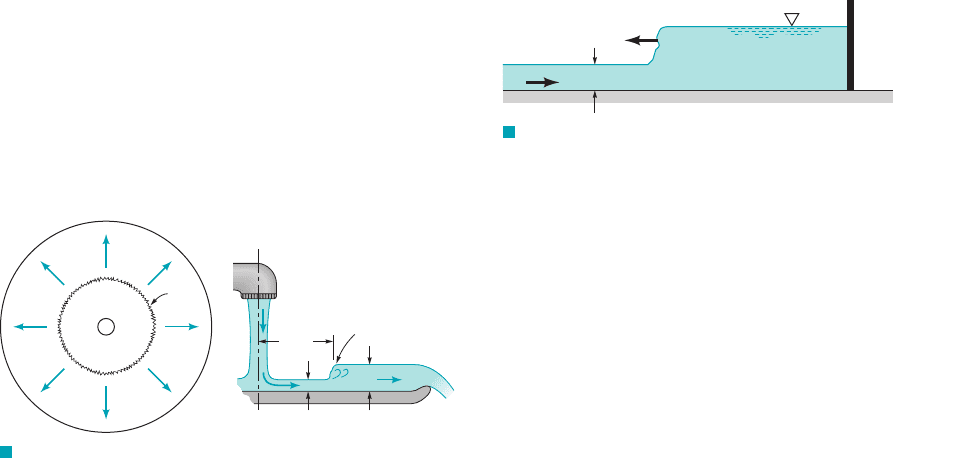
during a heavy rain storm. The cross section of the gutter is shown
in Fig. P10.85. Determine the vertical distance that this gutter must
be pitched 1i.e., the difference in elevation between the two ends
of the gutter2so that the water does not overflow the gutter. Assume
uniform depth channel flow.
Section 10.6.1 The Hydraulic Jump (Also see Lab
Problems 10.116 and 10.117.)
10.86 Obtain a photograph image of a situation that involves a
hydraulic jump. Print this photo and write a brief paragraph that
describes the flow.
10.87 Water flows upstream of a hydraulic jump with a depth of
0.5 m and a velocity of Determine the depth of the water
downstream of the jump.
10.88 A 2.0-ft standing wave is produced at the bottom of the
rectangular channel in an amusement park water ride. If the water
depth upstream of the wave is estimated to be 1.5 ft, determine
how fast the boat is traveling when it passes through this standing
wave 1hydraulic jump2for its final “splash.”
10.89 The water depths upstream and downstream of a hydraulic
jump are 0.3 and 1.2 m, respectively. Determine the upstream
velocity and the power dissipated if the channel is 50 m wide.
10.90 Under appropriate conditions, water flowing from a faucet,
onto a flat plate, and over the edge of the plate can produce a circular
hydraulic jump as shown in Fig. P10.90 and Video V10.12. Consider
a situation where a jump forms 3.0 in. from the center of the plate
with depths upstream and downstream of the jump of 0.05 in. and
0.20 in., respectively. Determine the flowrate from the faucet.
6 m
s.
576 Chapter 10 ■ Open-Channel Flow
and velocity of the uniform flow upstream of the jump are 0.5 m
and respectively. Determine the value of h if the flow
downstream of the jump is to be uniform flow.
10.96 At a given location in a 12-ft-wide rectangular channel the
flowrate is 900 ft
3
s and the depth is 4 ft. Is this location upstream
or downstream of the hydraulic jump that occurs in this channel?
Explain.
*10.97 A rectangular channel of width bis to carry water at flowrates
from The water depth upstream of the hydraulic
jump that occurs 1if one does occur2is to remain 1.5 ft for all cases.
Plot the power dissipated in the jump as a function of flowrate for
channels of width 20, 30, and 40 ft.
10.98 Water flows in a rectangular channel at a depth of
and a velocity of When a gate is suddenly placed across
the end of the channel, a wave 1a moving hydraulic jump2travels
upstream with velocity as is indicated in Fig. P10.98. Determine
Note that this is an unsteady problem for a stationary observer.
However, for an observer moving to the left with velocity the
flow appears as a steady hydraulic jump.
V
w
,
V
w
.
V
w
V 20 ft
s.
y 1 ft
b 10,
30 Q 600 cfs.
8 m
s,
F I G U R E P10.90
Jump
3 in.
Jump
0.05 in. 0.20 in.
10.91 Show that the Froude number downstream of a hydraulic
jump in a rectangular channel is times the Froude number
upstream of the jump, where (1) and (2) denote the upstream and
downstream conditions, respectively.
10.92 Water flows in a 2-ft-wide rectangular channel at a rate of
If the water depth downstream of a hydraulic jump is 2.5 ft,
determine (a) the water depth upstream of the jump, (b) the
upstream and downstream Froude numbers, and (c) the head loss
across the jump.
10.93 A hydraulic jump at the base of a spillway of a dam is such
that the depths upstream and downstream of the jump are 0.90 and
3.6 m, respectively (see Video V10.11). If the spillway is 10 m
wide, what is the flowrate over the spillway?
10.94 Determine the head loss and power dissipated by the
hydraulic jump of Problem 10.93.
10.95 A hydraulic jump occurs in a 4-m-wide rectangular channel
at a point where the slope changes from 3 m per 100 m upstream
of the jump to h m per 100 m downstream of the jump. The depth
10 ft
3
s.
1y
1
y
2
2
3
/
2
F I G U R E P10.98
V
y
V
w
V = 0
10.99 Water flows in a rectangular channel with velocity
. A gate at the end of the channel is suddenly closed
so that a wave (a moving hydraulic jump) travels upstream with
velocity as is indicated in Fig. P10.98. Determine the
depths ahead of and behind the wave. Note that this is an unsteady
problem for a stationary observer. However, for an observer moving
to the left with velocity V
w
, the flow appears as a steady hydraulic
jump.
10.100 (See Fluids in the News article titled “Grand Canyon
rapids building,” Section 10.6.1.) During the flood of 1983, a large
hydraulic jump formed at “Crystal Hole” rapid on the Colorado
River. People rafting the river at that time report “entering the
rapid at almost 30 mph, hitting a 20-ft-tall wall of water, and exit-
ing at about 10 mph.” Is this information (i.e., upstream and down-
stream velocities and change in depth) consistent with the princi-
ples of a hydraulic jump? Show calculations to support your
answer.
Section 10.6.2,3 Sharp-Crested and Broad-Crested
Weirs (Also see Lab Problems 10.114 and 10.115.)
10.101 Obtain a photograph image of a situation that involves a
weir. Print this photo and write a brief paragraph that describes the
flow.
10.102 Water flows over a 2-m-wide rectangular sharp-crested
weir. Determine the flowrate if the weir head is 0.1 m and the
channel depth is 1 m.
10.103 Water flows over a 5-ft-wide, rectangular sharp-crested
weir that is tall. If the depth upstream is 5 ft, determine
the flowrate.
10.104 A rectangular sharp-crested weir is used to measure the
flowrate in a channel of width 10 ft. It is desired to have the channel
flow depth be 6 ft when the flowrate is 50 cfs. Determine the height,
of the weir plate.P
w
,
P
w
4.5 ft
V
w
2 m
s
V 6 m
s
JWCL068_ch10_534-578.qxd 9/23/08 11:56 AM Page 576
